“Clear De Road,” the Emancipation 175 Exhibit at the Fort Frederik Museum, has evolved into a myriad of artistic documentations culminating with Part 4, the conclusion of the artists whose “decolonial work recenters the narrative to ensure it speaks from inside the Virgin Islands and for the Virgin Islands.
This series has come a long way and it is not the end of what the Division of Libraries, Archives, and Museums has to contribute. Its partnership with the 175th Emancipation Commemorative Committee, sponsored by First Bank, with support from the Office of the Governor, shares the importance of the documentation of all the artists who have come together with their talents so that the Virgin Islands community is aware of all that it has to offer.
Part one, part two, and part three give voice and pay homage to the ancestors. They continue in the same thread and are an invitation to the community to come together as one in the knowledge of the ancestors’ work toward freedom. This is the freedom that the people of the Virgin Islands, as their descendants, live and move and have in this present day.
Janet Cook-Rutnik moved to St.John in 1969, when her work as an artist had already begun, yet at a time when her visual ideas and sensibilities were shaped by the Caribbean. Cook-Rutnik moved from the typical West Indian landscapes to art methods that delved into historical and cultural memory. She used digital photography, video, and archival materials that reconceptualized the presentation of V.I. history in a way that would renew cultural memory. Anyone who knows Cook-Rutnik’s work is privy to an enrichment of material she has referenced to colonialism and its impact on the Virgin Islands.
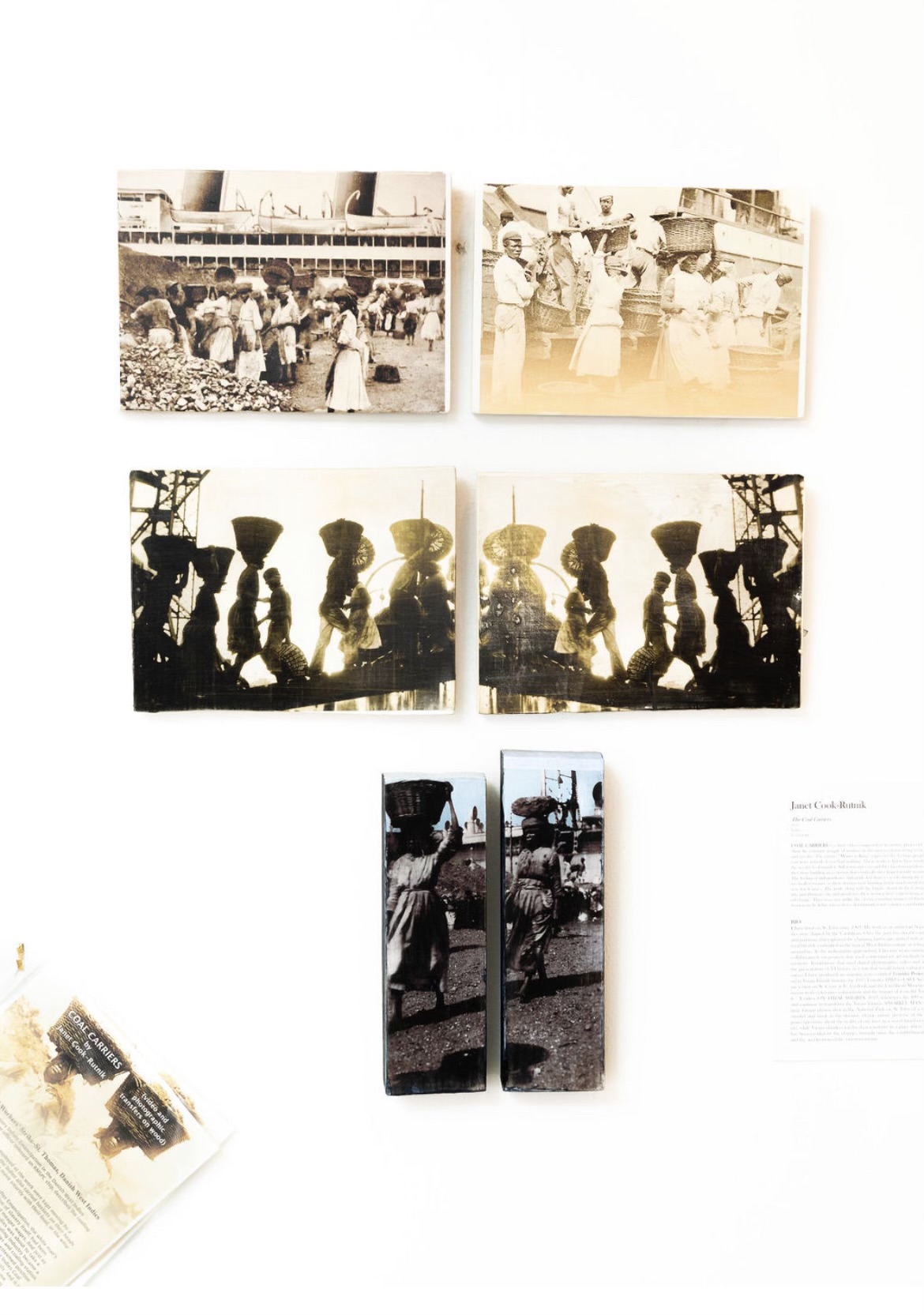
The Coal Workers Strike of 1892 is Cook-Rutnik’s offering of resistance as these women workers were bringing home much-needed money to support their families during very harsh times. There is pride, yet fatigue, shown in these images that illuminate the changing economies. There is independence these women experienced as they found their voices and demanded change. “They were not unlike the strong crusading women of the Firefurn, 14 years earlier, or the Kob Flat women on St. John, whose determination was a major contributing factor to the 1733 rebellion,” Cook-Rutnik said.
Sara Lee Hayes is a self-taught clay artist/potter on St. Croix for over 40 years. Her pottery training classes began in 1974 with adult education classes at a local high school and it has continued with books and videos, trial and error, and lots of patience, Hayes shared. She has been recognized as a Culture Bearer for the Virgin Islands by the V.I. Education Department. She brings local culture into much of her work and teaching.
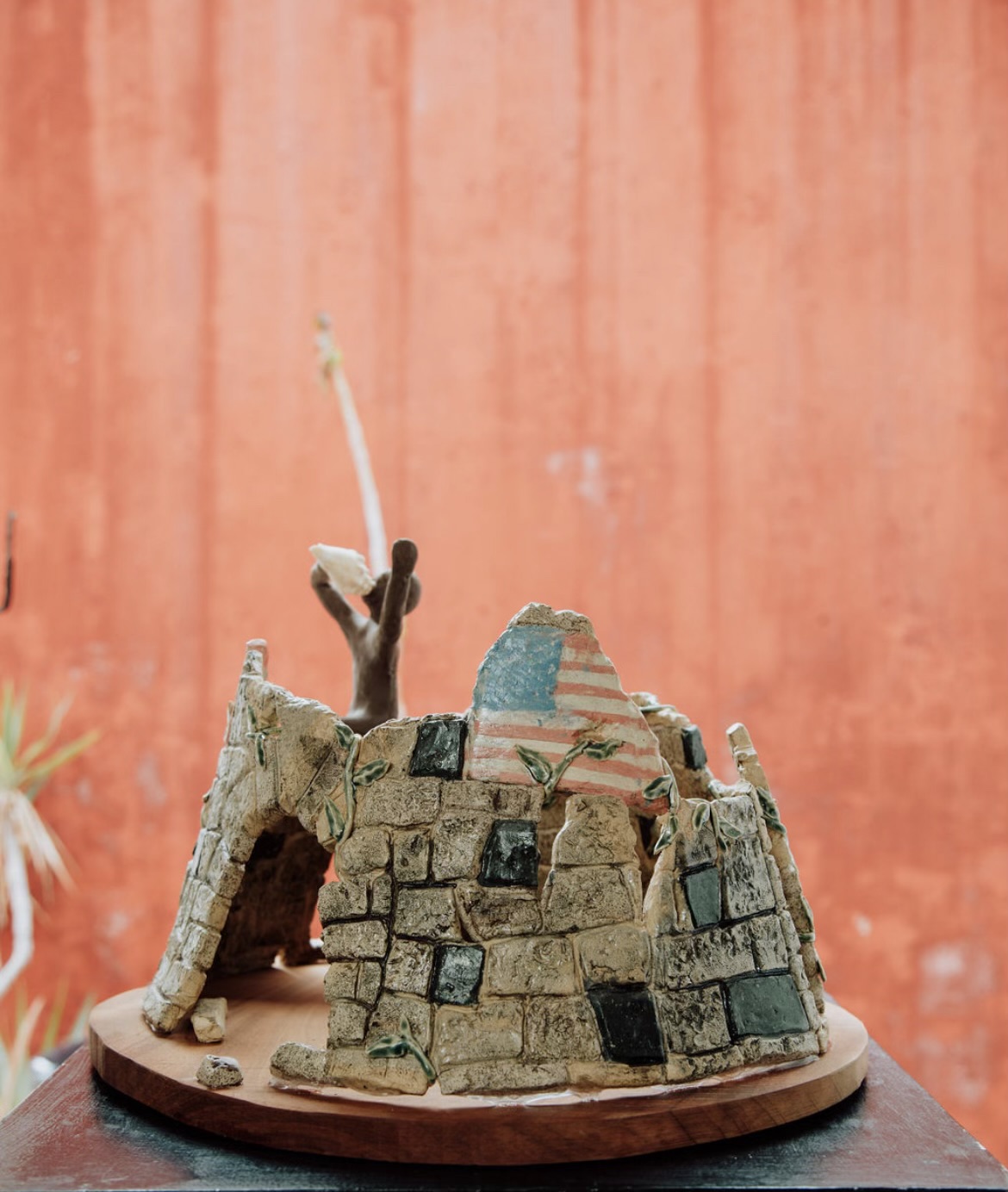
The Sugar Mill is the iconic landmark on St.Croix. Although a romantic history of plantation life to a visitor, the sugar mill was once a functioning entity driving the slave trade and eventually causing much of the pain and suffering to humans. “We are still not free of the colonial energy imbued in the sugar mills and in truth…we are still not fully emancipated,” Hayes said.
Augustin Kelvin Holder is a lifelong student of the Humanities. Art has always been a part of Holder’s curriculum. He studied at the University of the Virgin Islands, the University of Alaska, and the University of Hawaii. He continued his art studies and theory in New York at the Art Student League, MOMA, and the Brooklyn Museum.
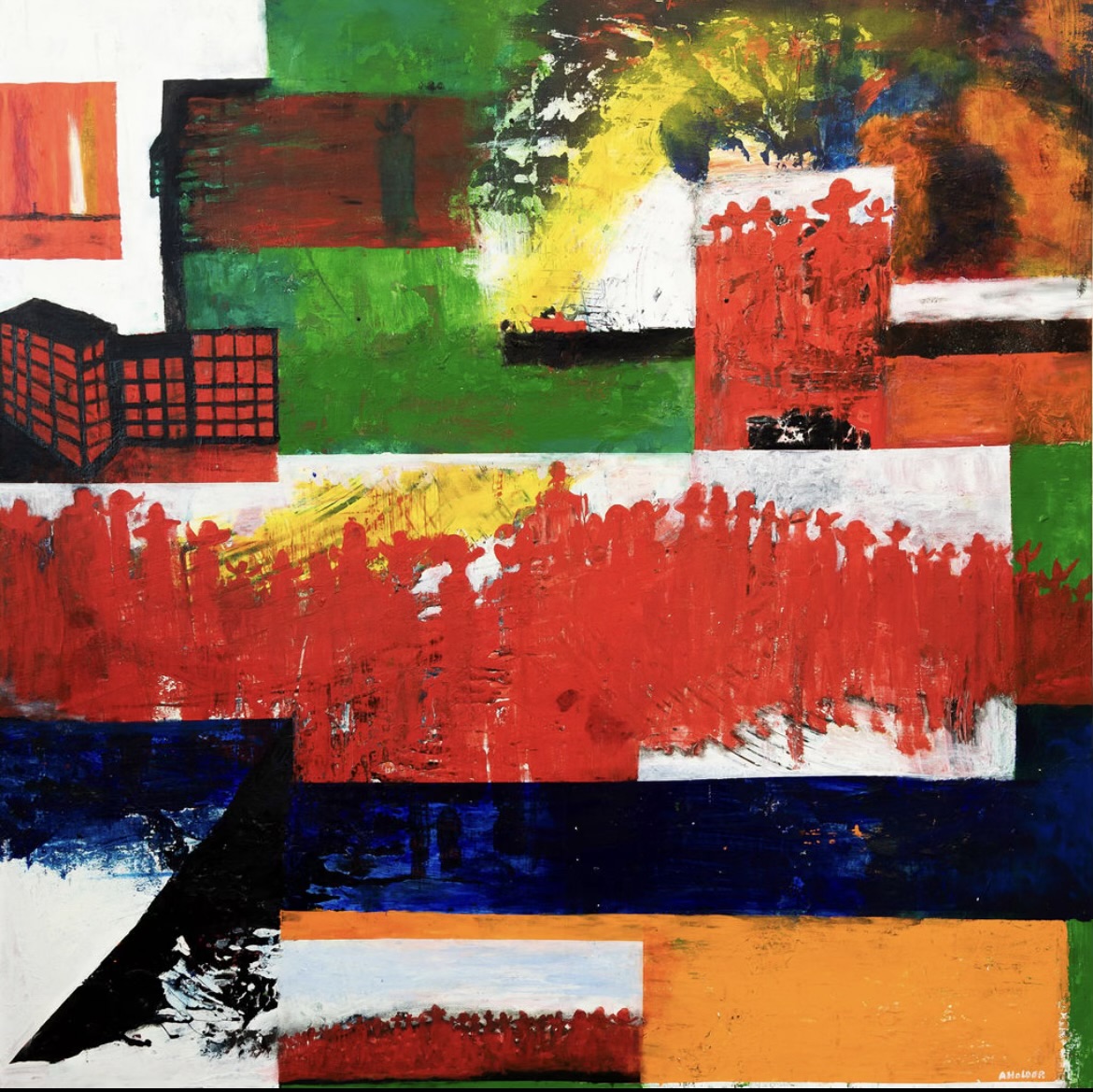
March for Freedom is a collage of several compositions that tell the story of self-awareness and determination. Holder uses bold and bright colors to intensify the composition and create vibrancy and depth. “The character represented throughout this composition is the main meme in this story. He is omnipresent and is one of many. I refer to him as ‘Mr. Nocturnal’ on occasion. He is a leader. He gives guidance and comforts you when in despair. The duality of his character comes to life in the painting. He is often mischaracterized and called a midnight marauder based on his looks, however, this character represents love, charity, and hope. He is your guardian angel who leads you to the path of safety and freedom,” Holder said.
Lucien Downes is a Caribbean-born artist and curator. Downes’ work demonstrates freedom of thought and expression through mixed media.
His art brings forth a culturally rich consciousness of his Trinidadian, Bajan, and Crucian ancestry. Downes is in the 13th year of his self-taught journey of creating art that utilizes resin, acrylic, fibers, raw pigments, plexiglass, ink, dyes, and occasionally found objects. Spiritual and worldly elements function independently and, at times, merge to encompass a whole in the composition of his work. His art has been highlighted in several publications and is often showcased as murals and community projects, and many grace the walls in the homes of Gov. Albert Bryan Jr., Maya Angelou, Teddy Riley, Jeff Johnson, and other private collectors.
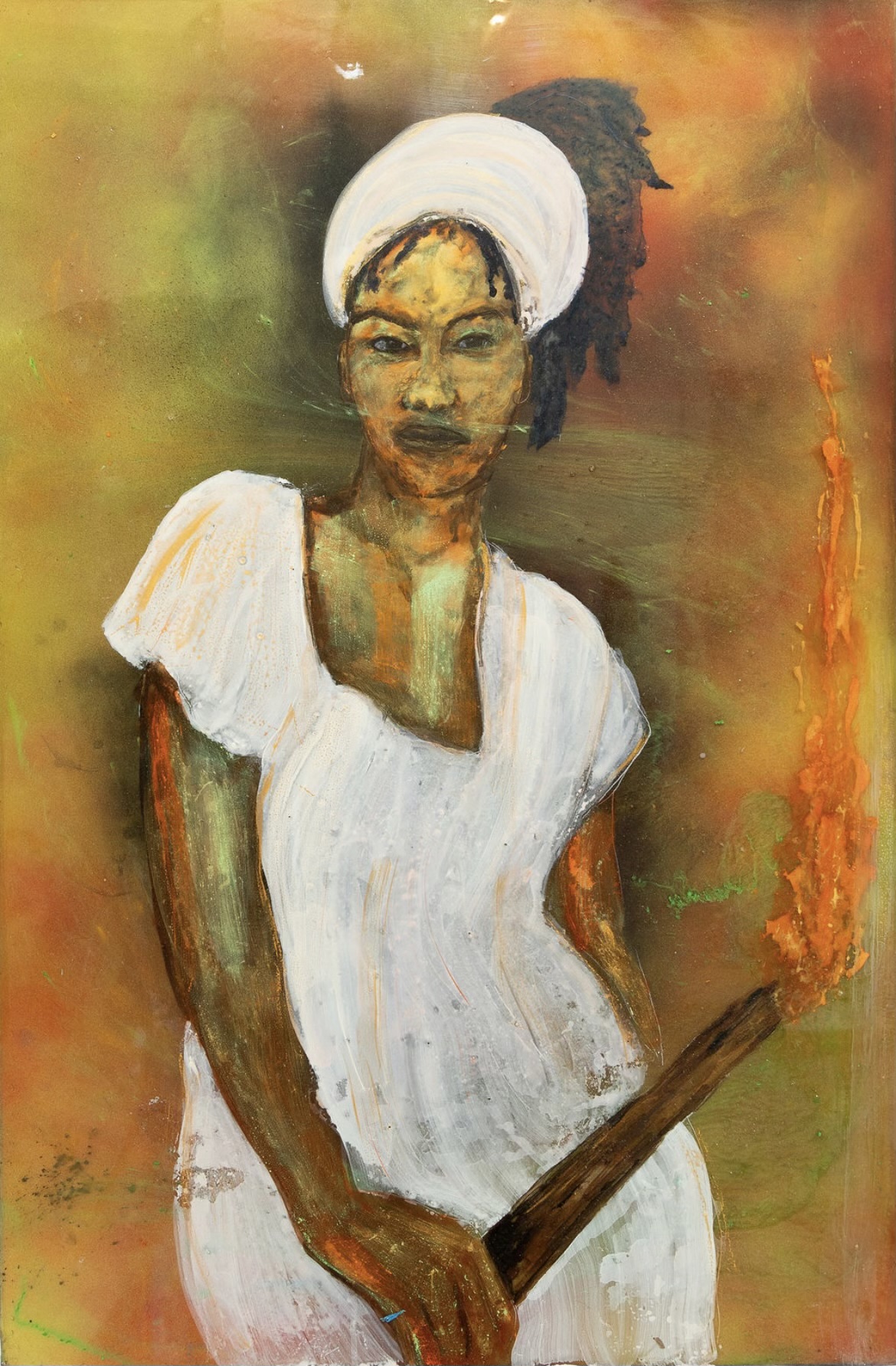
Fire Princess is the powerful and strong-willed woman who marched into Frederiksted town with torch in hand together with others who were willing to fight and burn everything down. Buddhoe led the charge as they followed in tow. July 3 was the day slavery was abolished and Emancipation proclaimed.
Waldemar Brodhurst is a Crucian artist who works exclusively in found and recycled materials. Cable, rope, barbed wire, glass, wood, screening, and fabric are all fair game for his extraordinary imagination and ability to turn trash into artful treasures. His human and animal subjects are all fused with their own unique vitality and self-possession. Brodhurst has a deeply held respect and admiration for the strength and vulnerability of women that is expressed in his sculptures. He has derived this appreciation from the courage and suffering he witnessed in his own mother. Brodhurst struggled for years and found the ability to channel and release his feelings into his sculptures. His work and the man himself are a testament to the transformative power of art.
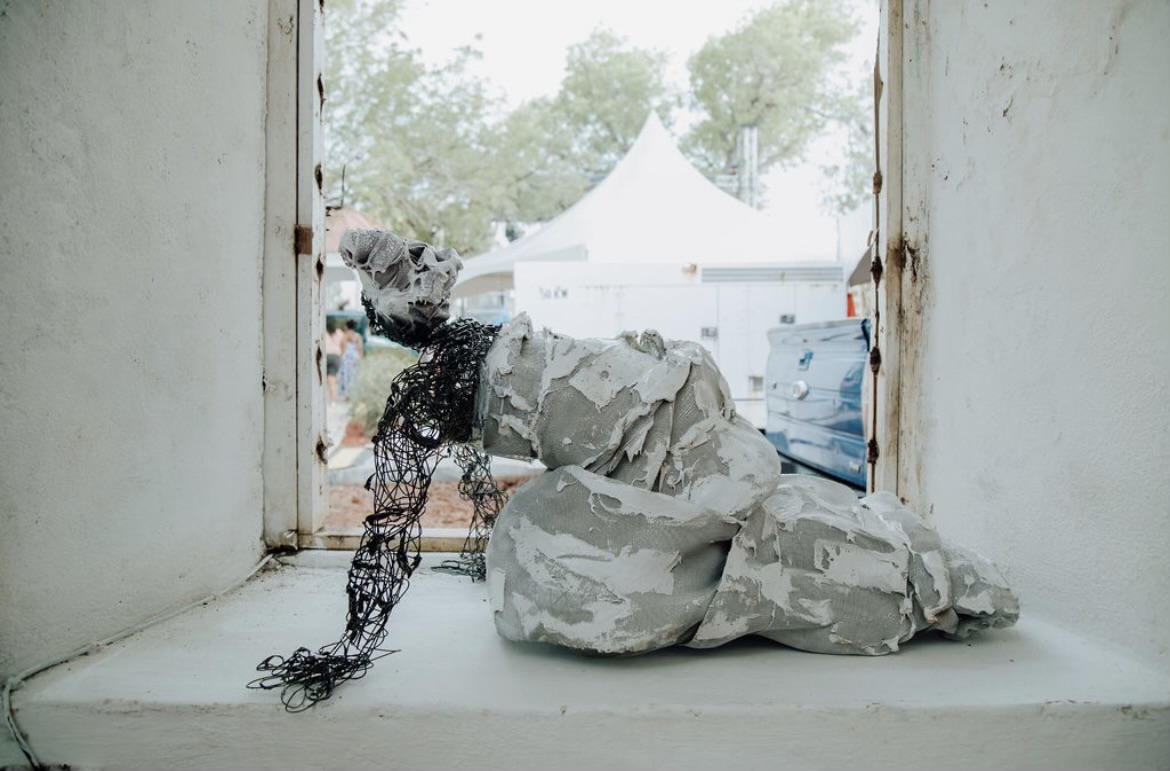
Ray Llanos is a Crucian artist who grew up on St. Croix until the age of 12 years. Living in the metropolitan area of Washington, DC, Llanos was privy to skateboarding, music and art. Through his travels to Toronto, Canada and Trinidad and Tobago, Llanos began to document the many carnival scenes he experienced. In 2002, he started a mentoring relationship with David ‘Oggi’ Ogburn in photography, business, etiquette and technique. Llanos later began building his career as an event photographer among the Caribbean community and the Harlem arts and culture scenes. His work has been exhibited as documentary and fine art photography at the Studio Museum in Harlem, The Museum of the City of New York, The African American Museum in Philadelphia, the Schomburg Center for Black Culture and Research, and the United Nations. The photography of Ray Llanos has been published in the New York Times and a myriad of online publications. He works and resides in Maryland, New York City, and on St. Croix.
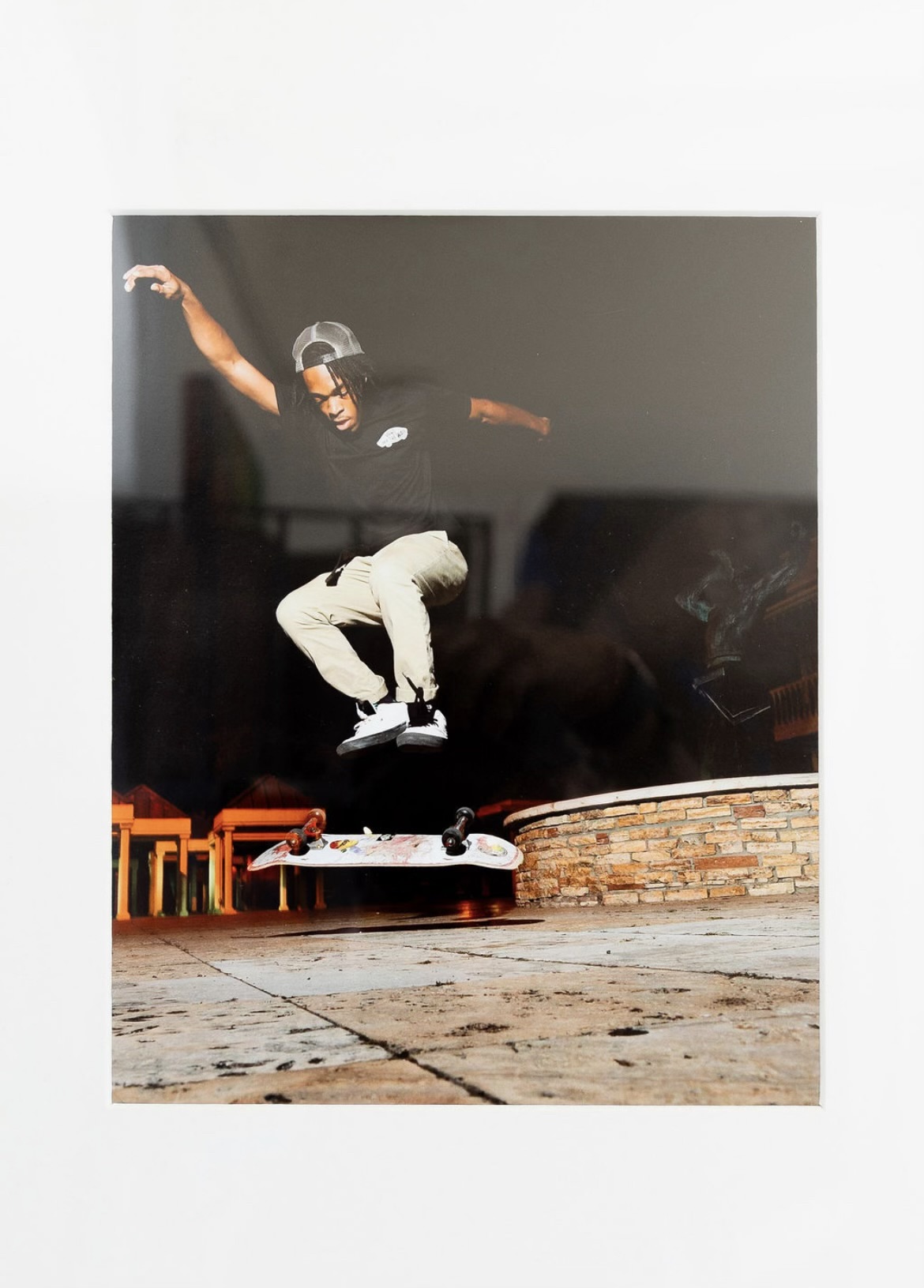
Skateboarding is one of the most creative forms of expression that Llanos possesses. It was this exposure to the creative outlets that would eventually “shape my decisions, spawn relationships, and open doors all my life.” Llanos reminisces about the Charlotte Amalie J’Ouvert tramps and of joining his mom in the striking teachers’ union in Christiansted in the early 80s. The expression “Clear de Road” has taken on a different meaning in his life. “People take to the streets out of frustration or at a time of revelry. In skateboarding…to hit the streets is a necessity,” Llanos shared. “Skateboarding has grown from an underground culture that embraced only a few into the global phenomenon and Olympic sport it is today.” Llanos’ image represents “freedom of expression, acts of resistance against status quo sports, and rebellion against a society that has not yet provided a space for youth (and adults) to freely create and grow,” Llanos said.
Victoria Rundberg-Rivera, M.D., is an emerging self-taught artist. She retired from her New York medical practice in 2014 to pursue her first love, writing. In the process, she discovered a new passion for painting.
A long-time woodworker, she began drawing and painting for the first time, primarily encompassing portraits and interpretive island scenes. Since 2015, her work has been exhibited on St. Croix at Top Hat Gallery, Caribbean Museum Center for the Arts, St.George Village Botanical Garden, Frederiksted Town (wall murals), The Women’s Coalition of St. Croix Gala, Cane Roots Art Gallery, Fort Frederik, Crucian Heritage and Nature Tourism, St. Croix Agriculture Fairgrounds, Bethlehem Sugar Factory, and local World Ocean School Fundraisers. Rivera currently resides with her family between St. Croix, USVI, Puerto Rico, and Nashville, TN. “Actively participating in my community as a ‘Crucian by choice’ offers a visibility I had never before encountered, where exploring my Puerto Rican, Afro-Caribbean and indigenous American cultural heritage through my art is both safe and celebrated,” Rundberg-Rivera said.

Mocko Jumbies & Masqueraders as participants, express and celebrate emancipation and freedom. As cultural protectors, they embody living reminders of practices rooted in resistance to colonial oppression and Eurocentric religiosity. As seekers, they strive to impart these traditions to our youth while dancing our histories throughout our village streets.
Cynthia Oliver is a St. Croix, Virgin Island-reared dance maker, performer and scholar. Her work incorporates textures of Caribbean performance with African and American aesthetic sensibilities. Oliver has toured the globe with contemporary companies, David Gordon Pick Up Co., Donald K. Brown/Evidence, Bebe Miller Company, and Tere O’Connor Dance. She has acted in works by Laurie Carlos, Greg Tate, Ione, Ntozake Shange, and Deke Weaver. Oliver earned a Ph.D. in performance studies from New York University and has won numerous awards in her field of dance. She is a professor in the dance department at the University of Illinois, Urbana-Champaign. Oliver is a widely published author with articles in a variety of journals and edited volumes. Her single-authored book is titled “Queen of the Virgins: Pageantry and Black Womanhood in the Caribbean.” Her last evening-length performance work, “Virago-Man Dem,” premiered at Brooklyn Academy of Music’s (BAM) Next Wave Festival 2017 and toured the country. Oliver is a 2021 United States Artist, A 2021 Doris Duke Artist, and a 2022 John Simon Guggenheim Fellow.
Fungi’s Lies: Tall tale telling and male vocal performance as Crucian liberatory strategies through the 1980s
“In the late 1980s, I performed a series of interviews with storytelling performer Alvin ‘Fungi’ James. Materials from those interviews have never been published. I believe the importance of the 175th Emancipation celebration is the proper setting for a record of the work of this local culture bearer, storyteller, and tall tale performer. James was a local artist hose work in the Virgin Islands was a critical part of Doc James’ radio and television productions in the 1980s. Fungi was a dream weaver, spectacular tall tale teller who, like Anansi the spider, provided subjects the route and ‘roots’ to escape hrm and come out on top. He swore he was telling the truth, defined and defied what ‘untruth’ might be. In them, we were central, fanciful, powerful, supernatural. These were survival strategies of the then and the now. This brief video and accompanying paper presents Fungi’s work and liberation policies. In it, we see the centrality of black male cultural production and its presence in the aural landscape and the ways it reflects and reproduces our vibrant and ever changing imagination,” Oliver said.
Clear de Road was curated by Monica Marin and co-produced by Akeem McIntosh, chair of the 175th EEC’s Subcommittee on Education and Public Display, with exhibition installation and assistance from Niarus Walker and Ralph Motta.
For more information:
Call Fort Frederik Museum at 340-772-2021


